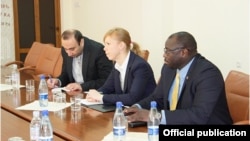A visiting senior U.S. official met with Armenian government representatives and businesspeople in Yerevan on Wednesday to advise them on ways of capitalizing on Armenia’s mostly tariff-free access to the U.S. market.
The U.S. deputy chief of mission in Armenia spoke meanwhile, of a “tremendous amount of potential” for increasing U.S.-Armenian trade. “We see no limits actually,” said Clark Price. “We are very enthusiastic about the potential.”
“We’re not just talking about American exports to Armenia. We’re supporting Armenian exports to the U.S. truly in a bilateral way,” Price told RFE/RL’s Armenian service (Azatutyun.am).
Armenia is among 122 countries included in the U.S. Generalized System of Preferences (GSP) program, which fully or partly exempts many goods manufactured by them from U.S import duties.
Despite these trade preferences, Armenian exports to the United States have been quite modest to date. Official Armenian statistics for 2015 put them at just $55 million. U.S. exports to Armenia were worth twice as much last year.
According to Armenia’s Economy Ministry, although most of those exports are covered by GSP, many other Armenian manufacturing firms still do not take advantage of the preferential trade regime with the U.S. Some of their owners and managers attended on Wednesday a seminar on GSP organized by the ministry and the U.S. Embassy in Yerevan.
Aimee Larsen, a senior official from the Office of the U.S. Trade Representative (USTR), was on hand to present business opportunities stemming from GSP and legal procedures for qualifying for the trade scheme. She also answered questions from participants of the seminar.
“I’m here today to help increase the awareness of the GSP program that gives duty-free access to Armenia over 3,500 products,” Larsen told RFE/RL’s Armenian service (Azatutyun.am). “I’m hoping that … Armenian exporters will be able to increase their trade with the United States.”
“Armenian exporters don’t know everything about GSP that they could, and the reason why Aimee is here is to explain that to them so that they can take advantage of it,” Price said for his part.
“It’s very important to put this in the context of U.S.-Armenian relations,” added the diplomat. “We had a [bilateral] Trade and Investment Council meeting last year for the first time. One of the things that the Armenian government asked us was help with GSP. So we are delivering on our promise.”
The council was set up in line with the U.S.-Armenian Trade and Investment Framework Agreement (TIFA) that was signed in Washington in May 2015. It is tasked with addressing obstacles to bilateral commercial ties.
The signing of the TIFA -- at a ceremony attended by President Serzh Sarkisian -- underlined Armenia’s desire to continue deepening its relations with the U.S. and the European Union even after its recent accession to the Russian-led Eurasian Economic Union (EEU).





